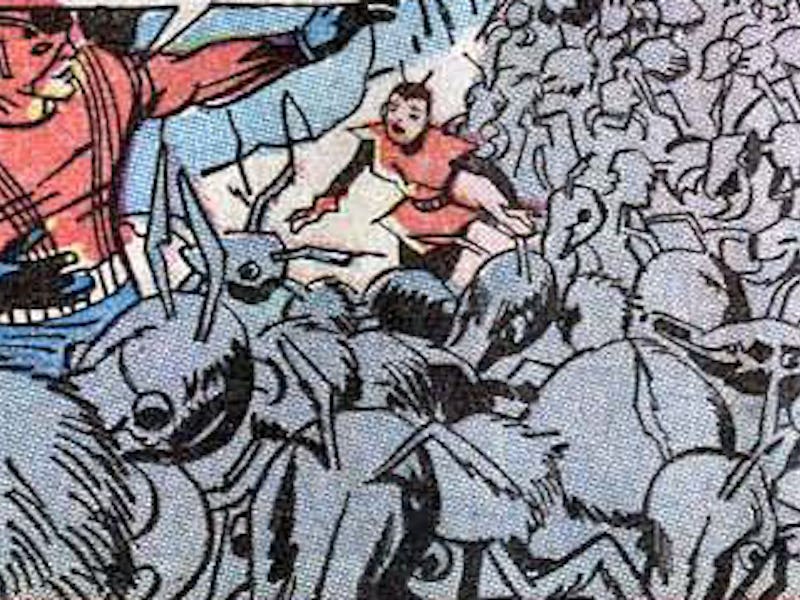An Entomologist's Scientific Review of 'Ant-Man'
Everything you ever wanted to know about pheromonal signaling but were afraid to ask.

John Cambridge is a doctoral student in the Entomology Department of Rutgers University’s School of Environmental and Biological Sciences. He is researching the diel activities of the Brown Marmorated Stink Bug in orchards. If you really want to learn about ants, he suggests reading E.O. Wilson’s Pulitzer Prize-winning The Ants.
Entomologically speaking, the thing Ant-Man has going for it is ants, lots of ants. Having been burned by the Spider Man movies, which feature shockingly few arachnids, I was pleased to see some carapaces getting screen time. That said, the portrayal of Formicidae lacked the verisimilitude that people with doctorate degrees expect from Marvel superhero movies. In truth, the details of Dr. Pym’s admirably close relationship with ants strained credulity.
The communication system between Dr. Pym and the ants was central to much of the movie’s action and based on some sort of technology that translated his desire into chemical cues the ants could pick up. I can’t speak to the feasibility of that technology, but I can point out that the chemical cues ants pick-up on lack nuance. No naturally occurring signal would encourage a group of ants to make a chandelier while dropping sugar cubes into a cup. A synthetic signal could surely be encoded with that information, but the ants would lack the sensitivity to pick it up. Examples of pheromonal ant cues include attack/defend, follow, and go forage. And it’s not a simple matter to layer these simple cues into complex commands. It would be impossible — from any distance at all — to send multiple pheromonal messages to specific recipients.
As for audible communication, ants don’t make a clicking or purring noise. If they do make noise, it’s more of a squeak that comes from the abdomen, not the mouth. They can hear, but Dr. Pam would likely find them impossible to train with noise as they lack a puppy’s ability to take cues. (Unlike a puppy, ants are phenomenally clean, which makes the dirtiness of the tunnels in this film quite troubling.)
In Ant-Man, Dr. Pym concerns himself primarily with the four types of ants he teaches Scott Lang/Ant-Man to control: carpenter ants, bullet ants, fire ants, and crazy ants. Let’s analyze these intra-species relationships separately.
Carpenter Ants: Ant-Man uses carpenter ants as a sort of winged Uber. That he takes advantage of them for transportation makes sense. Carpenter ants do carry a lot of leaves and such. That said, they only have wings when sent out from their colony to establish new colonies. The winged individuals would never carry anything and, in fact, are de-winged whenever they engage in antsy coitus. So, if Ant-Man were to accomplish these things, he’d have to have perfect timing and he’d have to be comfortable riding a sexually frustrated ant.
Bullet Ants: These guys are Ant-Man’s muscle. And justifiably so — they pack a serious sting. The movie makes reference to the Schmitt Pain Index, which does indeed demonstrate that this ant has one of the worst stings in the world, but the screenwriter gets the scale backwards. Stings get more painful as the numbers go up, not down.
Fire Ants: The Macgyvers of the group, fire ants are known to make rafts in the water, one of which Ant-Man uses to move through a plumbing system. The filmmakers were right to make them a bit smaller than the other ants shown. Of all the types portrayed, the fire ants will be the most recognizable to in-the-know ant-watchers.
Crazy Ants: The crazy ants, which appear to be loosely inspired by the Tawny Crazy Ant (Nylanderia fulva), are an entomological scandal. In the film, they are endowed with an incredible EM producing and conducting power, which tracks with the fact that they’re know for shorting out electric systems in the southeast U.S. But, here’s the catch, they short out electrics by eating wires. They are not scuttling Tesla coils.
My last entomological bone of contention concerns the film’s supersized ant. There is actually a famous theory question about the structure of the ant body and the strength of the insect exoskeleton. If an ant where made to be the same size as a German Shepherd, what would happen? The correct answer is that it would collapse under its own weight. Proportionality, it turns out, has its limits. Still, it was quite enjoyable to see a child feeding a giant ant-pet from the dinner table.
And enjoyable to see lots of ants. Ants are great.